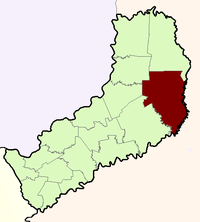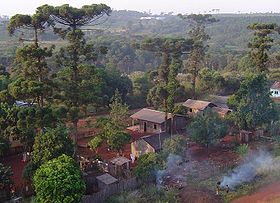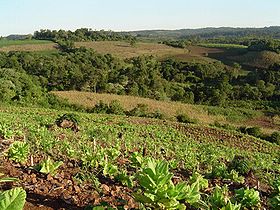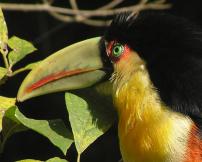
San Pedro Department, Misiones
Encyclopedia

Departments of Argentina
Departments form the second level of administrative division in the provinces of Argentina. There are no departments in the city of Buenos Aires, which has so far been divided into neighbourhoods as its administrative divisions, but is to be divided now into communes by a recently passed local act...
in the Misiones Province
Misiones Province
Misiones is one of the 23 provinces of Argentina, located in the northeastern corner of the country in the Mesopotamiсa region. It is surrounded by Paraguay to the northwest, Brazil to the north, east and south, and Corrientes Province of Argentina to the southwest.- History :The province was...
, Argentina
Argentina
Argentina , officially the Argentine Republic , is the second largest country in South America by land area, after Brazil. It is constituted as a federation of 23 provinces and an autonomous city, Buenos Aires...
. It covers an area of 3407 square kilometres and has a population of 24,000 people. San Pedro includes part of the Paraná River
Paraná River
The Paraná River is a river in south Central South America, running through Brazil, Paraguay and Argentina for some . It is second in length only to the Amazon River among South American rivers. The name Paraná is an abbreviation of the phrase "para rehe onáva", which comes from the Tupi language...
watershed, part of the Uruguay River
Uruguay River
The Uruguay River is a river in South America. It flows from north to south and makes boundary with Brazil, Argentina, and Uruguay, separating some of the Argentine provinces of the Mesopotamia from the other two countries...
watershed, and the Sierra Central that divides these two systems.
The Capital
The capital of San Pedro Department is the town of San Pedro. It is situated in the Sierra Central, at 26°38'S 54°07'W, 575 m a.s.l. The town is characterized by native Parana Pines or Kuri'y (Araucaria angustifoliaAraucaria angustifolia
Araucaria angustifolia, the Paraná pine or Brazilian pine , is a species in the conifer genus Araucaria. Covering an original area of 233000 km², it is native to southern Brazil Araucaria angustifolia, the Paraná pine or Brazilian pine , is a species in the conifer genus Araucaria. Covering an...
) scattered amongst the houses and small businesses.
Origins

Despite this fear, in 1840, a shortage of yerba mate
Yerba mate
Maté, yerba maté or erva maté , Ilex paraguariensis, is a species of holly native to subtropical South America in northeastern Argentina, Bolivia, southern Brazil, Uruguay and Paraguay...
(and resulting high prices) inspired an expedition to central Misiones. Yerba mate is a native plant used in infusion
Infusion
An infusion is the outcome of steeping plants with desired chemical compounds or flavors in water or oil.-History:The first recorded use of essential oils was in the 10th or 11th century by the Persian polymath Avicenna, possibly in The Canon of Medicine.-Preparation techniques:An infusion is very...
s, and harvested, at that time, from the Atlantic forest, where it grew wild.
Under the leadership of their chief, Fracran, the Kaingangues massacred the expedition members. The only survivor of the expedition was a young boy, Bonifacio Maidana, who was adopted by an influential member of the Kaingangues.
Over the next decades, Europeans kept away from central Misiones and the Kaingangues. Maidana grew up and gained power in the Kaingangue community. Finally, he disputed Fracran's leadership. Fracran escaped to Brazil, and Maidana replaced him as chief.
From that time on, the Kaingangues began seeking peace with the European colonists in the south, and finally, in 1876, Maidana signed the "pacto de la selva" or "treaty of the forest", permitting Europeans to harvest yerba mate in the area that today is San Pedro. The Treaty however failed to work and a War of extermination occurred. Many Kaingangues were killed and very few remain today.
The village of San Pedro was established. Some Kaingangues settled there; others left for Brazil; today, there are none left in Misiones.
Industry

Wood
Wood is a hard, fibrous tissue found in many trees. It has been used for hundreds of thousands of years for both fuel and as a construction material. It is an organic material, a natural composite of cellulose fibers embedded in a matrix of lignin which resists compression...
and tobacco
Tobacco
Tobacco is an agricultural product processed from the leaves of plants in the genus Nicotiana. It can be consumed, used as a pesticide and, in the form of nicotine tartrate, used in some medicines...
.
Population
Today, most people in San Pedro have subsistence farmFarm
A farm is an area of land, or, for aquaculture, lake, river or sea, including various structures, devoted primarily to the practice of producing and managing food , fibres and, increasingly, fuel. It is the basic production facility in food production. Farms may be owned and operated by a single...
s or work in forestry
Forestry
Forestry is the interdisciplinary profession embracing the science, art, and craft of creating, managing, using, and conserving forests and associated resources in a sustainable manner to meet desired goals, needs, and values for human benefit. Forestry is practiced in plantations and natural stands...
. San Pedro has the highest rate of poverty among Misiones' departments: 40% of people do not have their basic needs satisfied. Outside the town of San Pedro, only 15% of farmer
Farmer
A farmer is a person engaged in agriculture, who raises living organisms for food or raw materials, generally including livestock husbandry and growing crops, such as produce and grain...
s own their own land.
Natural Heritage

San Pedro's native vegetation
Vegetation
Vegetation is a general term for the plant life of a region; it refers to the ground cover provided by plants. It is a general term, without specific reference to particular taxa, life forms, structure, spatial extent, or any other specific botanical or geographic characteristics. It is broader...
is Atlantic forest or Mata Atlantica
Mata Atlântica
The Atlantic Forest is a region of tropical and subtropical moist forest, tropical dry forest, tropical savanna, semi deciduous forest and mangrove forests which extends along the Atlantic coast of Brazil from Rio Grande do Norte state in the north to Rio Grande do Sul state in the south, and...
, one of the world's most diverse and endangered ecosystems (Myers et al. 2000). In San Pedro, much of the remaining forest is protected in five provincial park
Provincial park
A provincial park is a park under the management of a provincial or territorial government in Canada.While provincial parks are not the same as national parks, their workings are very similar...
s and the UNESCO
UNESCO
The United Nations Educational, Scientific and Cultural Organization is a specialized agency of the United Nations...
Yaboti Biosphere Reserve. Cruce Caballero Provincial Park, just 6 square kilometres, protects some of the last remaining primary forest in Misiones.
San Pedro is famous for its Parana Pine (Araucaria angustifolia
Araucaria angustifolia
Araucaria angustifolia, the Paraná pine or Brazilian pine , is a species in the conifer genus Araucaria. Covering an original area of 233000 km², it is native to southern Brazil Araucaria angustifolia, the Paraná pine or Brazilian pine , is a species in the conifer genus Araucaria. Covering an...
) forest, protected in Cruce Caballero and Araucaria Provincial Parks. Threatened animal species associated with this forest include the Araucaria Tit-Spinetail (Leptasthenura setaria), the Brown Howling Monkey (Alouatta guariba), and the Vinaceous Amazon (Amazona vinacea).
External links
- INDEC 2001
- Proyecto Selva de Pino Parana. San Pedro, Misiones.
- Fiesta de la Araucaria. San Pedro, Misiones.

